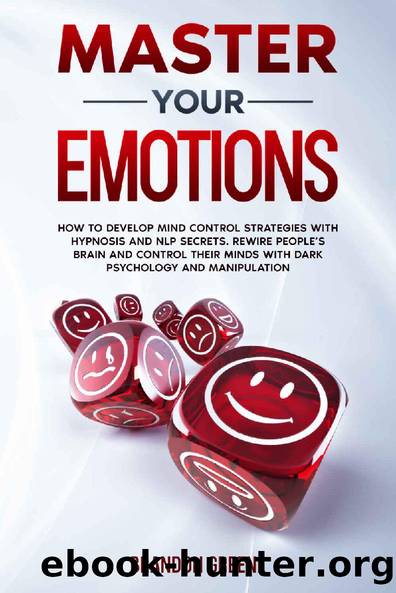Master Your Emotions: How to Develop Mind Control Strategies with Hypnosis and NLP Secret. Rewire People's Brain and Control their Minds with Dark Psychology and Manipulation by Brandon Greene

Author:Brandon Greene [Greene, Brandon]
Language: eng
Format: epub
Published: 2020-05-11T00:00:00+00:00
Chapter 25
Body Language
B eyond facial features, the body itself is just as expressive. The way the body moves can tell you a surprising amount of details about what is happening within the other personâs mind, ranging from feeling entirely uncomfortable with an interaction, to feeling confident, in control, and powerful. Keep in mind that some people may express themselves in different ways and that this suggestion should be approached as a guide and not a guarantee to help you identify any emotions in anyone else.
Head
The first part of the body you will learn about will be the head. The head, beyond expressions and facial features, can be moved in a wide variety of ways that can also help provide insight into the mind of another.
Tilt: People naturally direct their head toward those they feel a rapport, or connection, with. Even when that person is not necessarily talking in a group, people will unconsciously tilt their heads toward the leader of the group. It can also tilt toward someone that they feel a connection with. Conversely, tilting the head back, away from someone, implies distrust, suspicion, or being unsure in general. By tilting the head to the side, an individual encourages the other person to continue speaking.
Nod: When someone nods, it is usually a sign of affirmation, confirming the agreement, or confirming that the individual is listening. When someone nods quicker, it means they are growing impatient and want to disengage, but feel too polite to do so. When the nodding is slower and more thoughtful, it implies that the other person is still actively listening and engaged in the conversation.
Watch the chin: The chin, like the tilt of the head, can show a lot. When the chin is raised upwards, the neck is exposed. This is a sign of arroganceâit is essentially daring the other person to even try touching them or hurting them. When it is tucked downward, shielding the neck, however, it shows a level of insecurity.
Arms/shoulders
The way the arms are held can also be incredibly revealing. Take a look at some of the most common ways that arms are held and what they mean:
Arms pulled backward: When the arms are drawn backward, it is usually because the individual feels uncomfortable or defensive. In drawing backward, they are able to make their arms less available to grabâas the shoulders move away, they are less readily available during an attack.
Arms expanded: The arms can be expanded outward, relaxed at the shoulders and allowed to hang naturally. This is a sign of openness and comfort, implying that the other person is comfortable with what is happening at the moment.
Arms drawn inward: Conversely to expanding the arms, when the arms are pulled inward, the individual is seen as making him or herself smaller and therefore less of a target. It implies insecurity or discomfort.
Arms entirely still: When the arms are entirely still at the sides, they typically look quite unnatural, and for a good reasonâusually the other person is trying to control their arms to avoid exposing any body language that could be taken advantage of well ahead.
Download
This site does not store any files on its server. We only index and link to content provided by other sites. Please contact the content providers to delete copyright contents if any and email us, we'll remove relevant links or contents immediately.
Inner Engineering: A Yogi's Guide to Joy by Sadhguru(6446)
The Power of Now: A Guide to Spiritual Enlightenment by Eckhart Tolle(5347)
Fear by Osho(4496)
Ikigai by Héctor García & Francesc Miralles(3900)
The Art of Happiness by The Dalai Lama(3851)
The Ultimate Bodybuilding Cookbook by Kendall Lou Schmidt(3713)
Yoga Therapy by Mark Stephens(3577)
The Little Book of Hygge by Meik Wiking(3451)
Why Buddhism is True by Robert Wright(3291)
The Healing Self by Deepak Chopra(3266)
Being Aware of Being Aware by Rupert Spira(3088)
The Hatha Yoga Pradipika (Translated) by Svatmarama(3079)
Shift into Freedom by Loch Kelly(3032)
Wild Words from Wild Women by Stephens Autumn(2940)
Work Clean by Dan Charnas(2903)
Happiness by Matthieu Ricard(2890)
More Language of Letting Go: 366 New Daily Meditations by Melody Beattie(2852)
Yoga Body & Mind Handbook by Jasmine Tarkeshi(2752)
Why I Am Not a Feminist by Jessa Crispin(2588)
